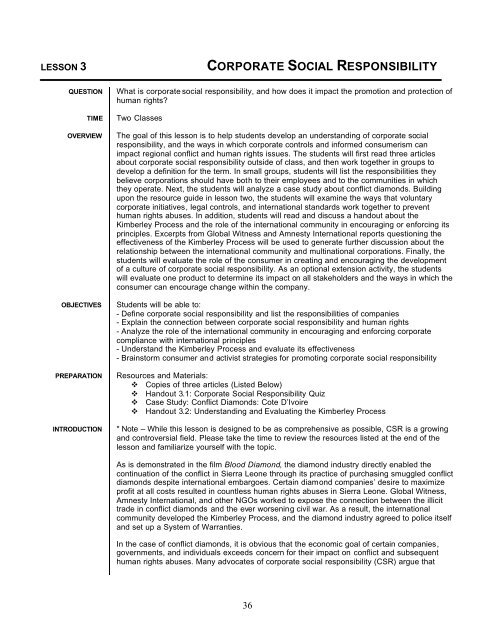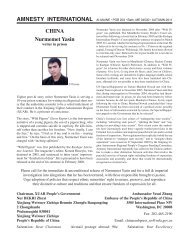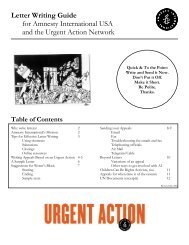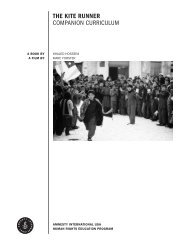Blood Diamond Curriculum Guide (PDF) - Amnesty International USA
Blood Diamond Curriculum Guide (PDF) - Amnesty International USA
Blood Diamond Curriculum Guide (PDF) - Amnesty International USA
You also want an ePaper? Increase the reach of your titles
YUMPU automatically turns print PDFs into web optimized ePapers that Google loves.
LESSON 3 CORPORATE SOCIAL RESPONSIBILITY<br />
QUESTION<br />
TIME<br />
OVERVIEW<br />
OBJECTIVES<br />
PREPARATION<br />
INTRODUCTION<br />
What is corporate social responsibility, and how does it impact the promotion and protection of<br />
human rights?<br />
Two Classes<br />
The goal of this lesson is to help students develop an understanding of corporate social<br />
responsibility, and the ways in which corporate controls and informed consumerism can<br />
impact regional conflict and human rights issues. The students will first read three articles<br />
about corporate social responsibility outside of class, and then work together in groups to<br />
develop a definition for the term. In small groups, students will list the responsibilities they<br />
believe corporations should have both to their employees and to the communities in which<br />
they operate. Next, the students will analyze a case study about conflict diamonds. Building<br />
upon the resource guide in lesson two, the students will examine the ways that voluntary<br />
corporate initiatives, legal controls, and international standards work together to prevent<br />
human rights abuses. In addition, students will read and discuss a handout about the<br />
Kimberley Process and the role of the international community in encouraging or enforcing its<br />
principles. Excerpts from Global Witness and <strong>Amnesty</strong> <strong>International</strong> reports questioning the<br />
effectiveness of the Kimberley Process will be used to generate further discussion about the<br />
relationship between the international community and multinational corporations. Finally, the<br />
students will evaluate the role of the consumer in creating and encouraging the development<br />
of a culture of corporate social responsibility. As an optional extension activity, the students<br />
will evaluate one product to determine its impact on all stakeholders and the ways in which the<br />
consumer can encourage change within the company.<br />
Students will be able to:<br />
- Define corporate social responsibility and list the responsibilities of companies<br />
- Explain the connection between corporate social responsibility and human rights<br />
- Analyze the role of the international community in encouraging and enforcing corporate<br />
compliance with international principles<br />
- Understand the Kimberley Process and evaluate its effectiveness<br />
- Brainstorm consumer and activist strategies for promoting corporate social responsibility<br />
Resources and Materials:<br />
� Copies of three articles (Listed Below)<br />
� Handout 3.1: Corporate Social Responsibility Quiz<br />
� Case Study: Conflict <strong>Diamond</strong>s: Cote D’Ivoire<br />
� Handout 3.2: Understanding and Evaluating the Kimberley Process<br />
* Note – While this lesson is designed to be as comprehensive as possible, CSR is a growing<br />
and controversial field. Please take the time to review the resources listed at the end of the<br />
lesson and familiarize yourself with the topic.<br />
As is demonstrated in the film <strong>Blood</strong> <strong>Diamond</strong>, the diamond industry directly enabled the<br />
continuation of the conflict in Sierra Leone through its practice of purchasing smuggled conflict<br />
diamonds despite international embargoes. Certain diamond companies’ desire to maximize<br />
profit at all costs resulted in countless human rights abuses in Sierra Leone. Global Witness,<br />
<strong>Amnesty</strong> <strong>International</strong>, and other NGOs worked to expose the connection between the illicit<br />
trade in conflict diamonds and the ever worsening civil war. As a result, the international<br />
community developed the Kimberley Process, and the diamond industry agreed to police itself<br />
and set up a System of Warranties.<br />
In the case of conflict diamonds, it is obvious that the economic goal of certain companies,<br />
governments, and individuals exceeds concern for their impact on conflict and subsequent<br />
human rights abuses. Many advocates of corporate social responsibility (CSR) argue that<br />
36






